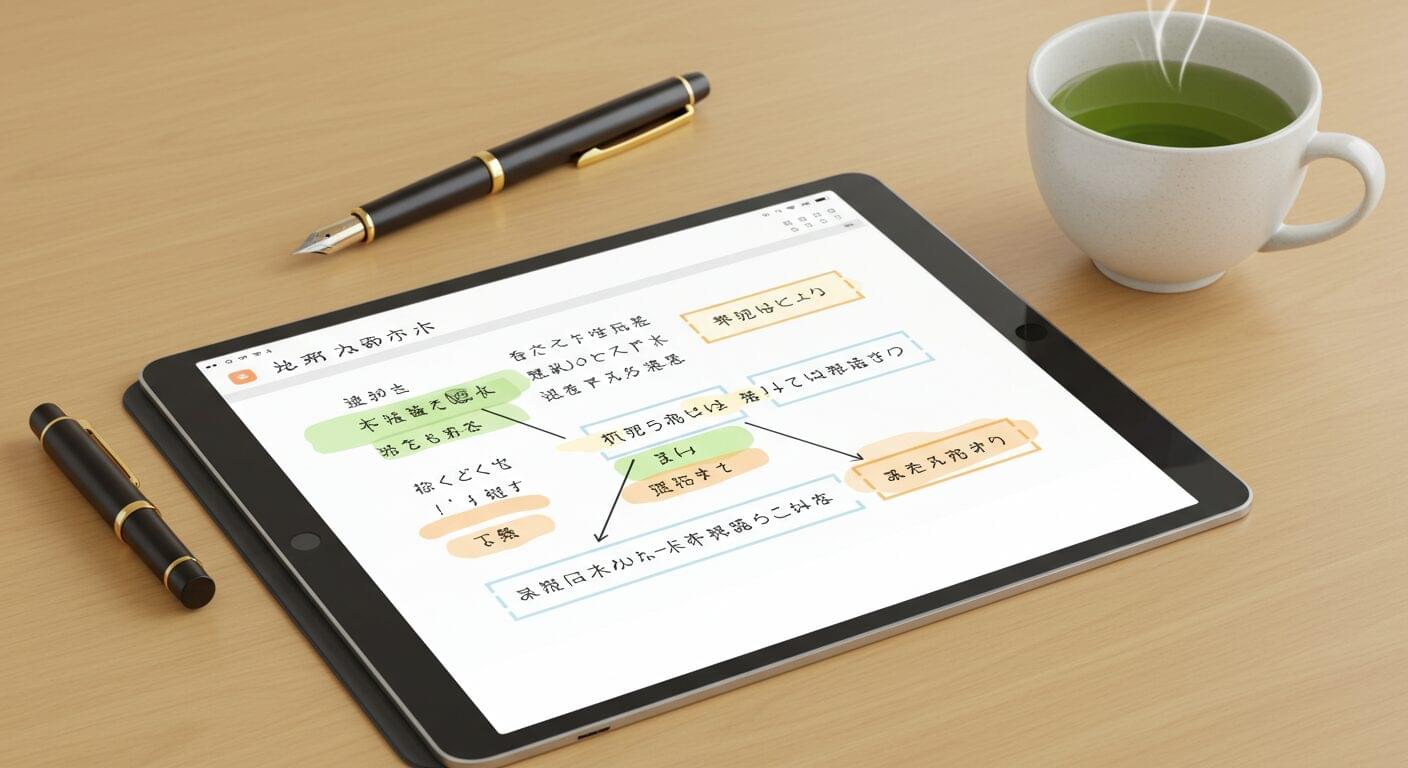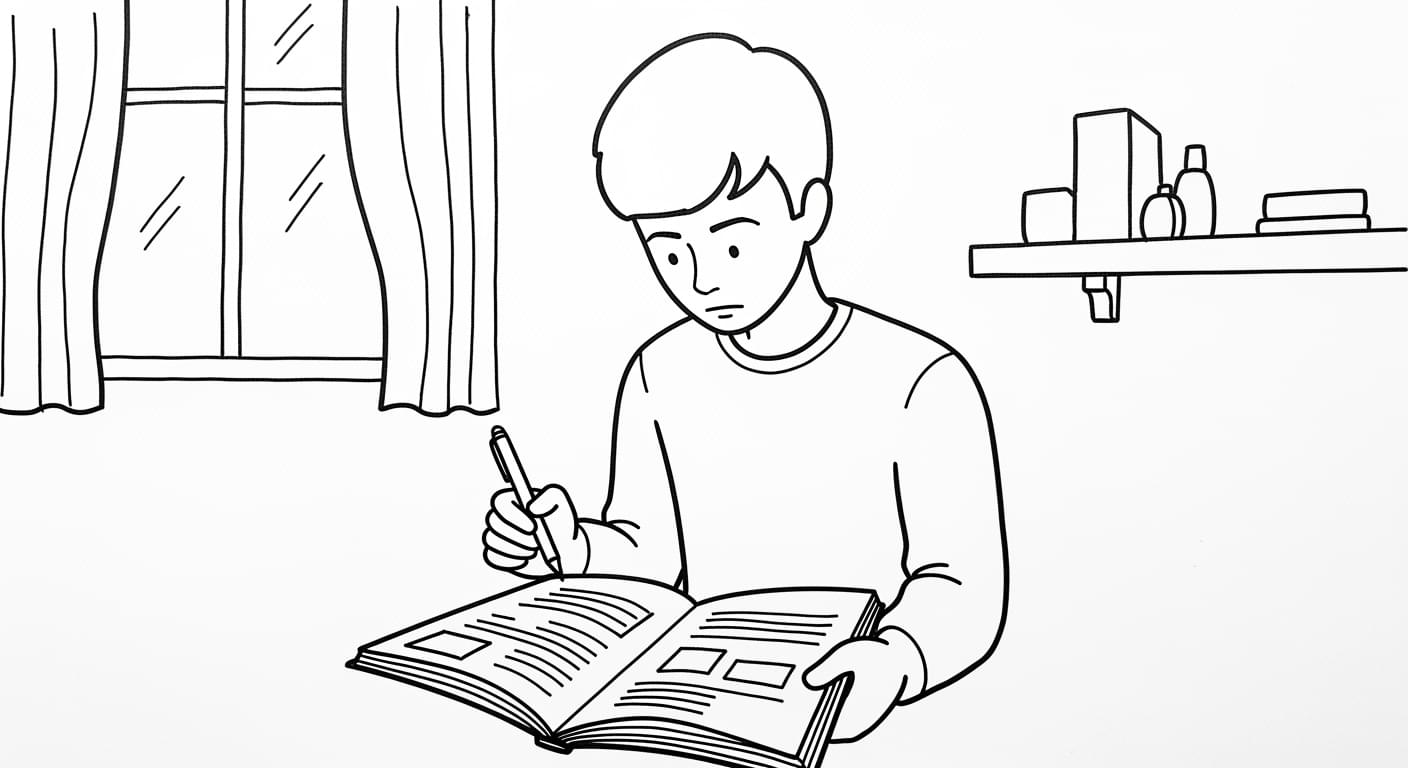「思いやり×Meaning:
Empathy, consideration, thoughtfulness. The ability to understand and share the feelings of another.
Grammar:
– Noun, often used to describe someone’s character or actions.
– Composed of 思い (omoi – thought, feeling) + やり (yari – doing, performing).
Usage: Describes the act of being considerate and understanding towards others. It implies not just understanding someone’s feelings but also acting in a way that shows you care.
Examples:
彼女は誰に対しても思いやりがある。
Kanojo wa dare ni taishitemo omoiyari ga aru.
She is considerate to everyone.
彼の思いやりのある言葉に感動しました。
Kare no omoiyari no aru kotoba ni kandou shimashita.
I was touched by his thoughtful words.
Register/Formality: Neutral, common word(おもいやり)」という言葉について、一緒に深く理解していきましょう!
ステップ1:身近な経験とつなげる
例えば、あなたが風邪を引いて体調が悪い時、友達が「大丈夫?何かできることある?」と声をかけてくれたとします。あるいは、電車の中でお年寄りの方に席を譲った×Meaning:
Yielded, gave way, handed over. Past tense of the verb ‘譲る’ (yuzuru).
Grammar:
– Verb in past tense.
– ‘譲る’ (yuzuru) means ‘to yield’, ‘to give way’, ‘to hand over’, ‘to concede’.
– In this context, it means ‘to give up one’s seat’ (to an elderly person).
Usage: Used to describe giving up something, often a seat or position, to someone else, usually out of politeness or consideration.
Examples:
私は彼女に席を譲った。
Watashi wa kanojo ni seki o yuzutta.
I gave her my seat.
彼は自分の意見を譲った。
Kare wa jibun no iken o yuzutta.
He yielded his opinion.
Register/Formality: Neutral, common verb経験もあるかもしれません。このように、相手の気持ちを考え、行動に移す×Meaning:
To take action, to put into action. To move from thought or consideration to actual behavior.
Grammar:
– Phrase: 行動 (koudou – action) + に (ni – particle indicating direction/target) + 移す (utsusu – to move, to shift).
– ‘移す’ (utsusu) is used here to mean ‘to transfer’ or ‘to shift’ something (in this case, consideration) into action.
Usage: Emphasizes the importance of not just thinking about something but actually doing something about it. It highlights the active aspect of ‘omoiやり’ (consideration).
Examples:
計画を行動に移す時が来た。
Keikaku o koudou ni utsusu toki ga kita.
The time has come to put the plan into action.
彼女はすぐにアイデアを行動に移した。
Kanojo wa sugu ni aidea o koudou ni utsushita.
She quickly put the idea into action.
Register/Formality: Neutral, common phraseこと、それが「思いやり」です。あなたも日々の生活×Meaning:
Daily life, everyday life. The routine and activities of a typical day.
Grammar:
– 日々 (hibi – days, daily) + の (no – possessive particle) + 生活 (seikatsu – life, living, lifestyle).
– 日々 (hibi) emphasizes the continuous, daily aspect.
Usage: Refers to the regular and ordinary aspects of someone’s life, what they do on a day-to-day basis.
Examples:
日々の生活は忙しい。
Hibi no seikatsu wa isogashii.
Daily life is busy.
彼は日々の生活を楽しんでいる。
Kare wa hibi no seikatsu o tanoshinde iru.
He is enjoying his daily life.
Register/Formality: Neutral, common phraseの中で、誰かに「思いやり」を示したり、誰かから「思いやり」を感じたりする瞬間があるのではないでしょうか。
ステップ2:橋をかける
「思いやり(おもいやり)」とは、相手の気持ちや状況を理解し、相手のことを考えて行動することを意味する言葉です。「思う(おもう)」に、相手の立場になって×Meaning:
Putting oneself in someone’s shoes, from someone’s perspective, in someone’s position. To imagine oneself in the situation of another person.
Grammar:
– 立場 (tachiba – position, standpoint, situation) + に (ni – particle indicating direction/location) + なって (natte – becoming, taking on the state of).
– ‘なる’ (naru – to become) in the te-form (なって – natte) indicates a state or condition.
Usage: Used to emphasize understanding or considering things from another person’s viewpoint. It’s a crucial concept in empathy and consideration.
Examples:
相手の立場になって考えてください。
Aite no tachiba ni natte kangaete kudasai.
Please think from the other person’s perspective.
もし私があなたの立場だったら…
Moshi watashi ga anata no tachiba dattara…
If I were in your position…
Register/Formality: Neutral, common phrase考えるという意味の「思い」と、行動を表す「やり」が組み合わさってできている×Meaning:
Is made up of combining, is formed by combining. Describes the process of something being created through combination.
Grammar:
– 組み合わさって (kumiawasatte – combining form of 組み合わさる – kumiawasaru – to be combined, to be joined together) + できている (dekite iru – is made up of, is formed – present continuous form of できる – dekiru – to be made, to be formed).
– ‘組み合わさる’ (kumiawasaru) is a compound verb of 組み (kumi – set, pair, group) + 合わさる (awasaru – to be joined together, to be combined).
Usage: Used to explain the composition or formation of something by combining different parts or elements.
Examples:
この料理はいくつかのスパイスが組み合わさってできている。
Kono ryouri wa ikutsuka no supaisu ga kumiawasatte dekite iru.
This dish is made up of a combination of several spices.
このチームは様々な才能が組み合わさってできている。
Kono chiimu wa samazama na sainou ga kumiawasatte dekite iru.
This team is formed by a combination of various talents.
Register/Formality: Neutral, descriptive phrase。単に考えるだけでなく、行動を伴う×Meaning:
To involve action, to accompany action. To not just think but also do something.
Grammar:
– 行動 (koudou – action) + を (o – direct object marker) + 伴う (tomonau – to accompany, to involve).
– ‘伴う’ (tomonau) means ‘to accompany’, ‘to go together with’, ‘to involve’.
Usage: Emphasizes that something is not just conceptual or mental, but also includes a practical or behavioral aspect. It highlights the active and practical side.
Examples:
計画はリスクを伴う。
Keikaku wa risuku o tomonau.
The plan involves risks.
成功は努力を伴う。
Seikou wa doryoku o tomonau.
Success involves effort.
Register/Formality: Neutral, common phrase点が重要です。
漢字で書くと「思い遣り」とも書きますが、ひらがなで「思いやり」と書かれることが多いです。日常生活の様々な場面で使われ、人間関係を円滑にする×Meaning:
To make smooth, to facilitate, to make harmonious. To improve relationships and make them function without friction.
Grammar:
– 円滑 (enkatsu – smooth, harmonious) + に (ni – adverbial particle) + する (suru – to do, to make).
– ‘円滑にする’ (enkatsu ni suru) is a verb phrase meaning ‘to make smooth’.
Usage: Often used in the context of relationships, processes, or operations to indicate making them run smoothly and without problems.
Examples:
会議を円滑にするために、事前に準備をした。
Kaigi o enkatsu ni suru tame ni, mae jizen ni junbi o shita.
I prepared in advance to make the meeting run smoothly.
コミュニケーションを円滑にする方法を学ぶ。
Komunikēshon o enkatsu ni suru houhou o manabu.
Learn how to facilitate smooth communication.
Register/Formality: Neutral to slightly formal, common phrase上でとても大切な要素×Meaning:
Element, factor. A necessary or contributing part of something.
Grammar:
– Noun.
– 単数形 (tansūkei – singular form), can be used in plural context depending on sentence.
Usage: Refers to a component or ingredient that is part of a larger whole, often in abstract contexts like qualities or conditions.
Examples:
努力は成功の重要な要素です。
Doryoku wa seikou no juuyou na youso desu.
Effort is an important element of success.
この計画にはいくつかの要素が含まれています。
Kono keikaku ni wa ikutsuka no youso ga fukumarete imasu.
This plan includes several elements.
Register/Formality: Neutral, common nounです。
ステップ3:例を通じて理解を深める
具体的な例を通して×Meaning:
Through concrete examples, by way of specific examples. Using real and tangible examples to explain something.
Grammar:
– 具体的な (gutaiteki na – concrete, specific) + 例 (rei – example) + を通して (o tooshite – through, by way of).
– ‘通して’ (tooshite) as a postpositional particle means ‘through’, ‘via’, ‘by means of’.
Usage: Indicates that the explanation or understanding will be achieved by using actual examples rather than abstract theory.
Examples:
具体的な例を通して説明します。
Gutaiteki na rei o tooshite setsumei shimasu.
I will explain through concrete examples.
経験を通して学ぶ。
Keiken o tooshite manabu.
Learn through experience.
Register/Formality: Neutral, common phrase、「思いやり」がどのように使われるのか見ていきましょう。
1.職場での場面:
田中さんはいつも周りの人の状況をよく見ていて、困っている人がいるとすぐに声をかける、思いやりのある人だ。
たなかさんは いつも まわりのひとの じょうきょうを よくみていて、こまっているひとが いると すぐに こえをかける、おもいやりのある ひとだ。
(Tanaka-san is always observant of the people around him, and he’s a considerate person who immediately offers help when someone is in trouble.)
この例では、田中さんが単に困っている人がいることに気づくだけでなく、実際に声をかけて助けようとする行動が「思いやりがある」と表現されています。
2.日常生活での場面:
電車の中で赤ちゃんが泣き出した時、隣に座っていた女性があやしてあげて×Meaning:
Soothing (a baby) for someone’s benefit. Trying to calm a crying baby, doing it for the baby’s or someone else’s sake.
Grammar:
– あやして (ayashite – te-form of あやす – ayasu – to soothe, to lull, to amuse (a baby)) + あげて (agete – auxiliary verb indicating benefit to someone else).
– ‘あげる’ (ageru) in this context is used as an auxiliary verb to show that the action is done for the benefit of another person (in this case, likely the baby or the baby’s mother).
Usage: Used specifically when talking about soothing a baby, and the ‘あげて’ part adds a nuance of doing it as a kind gesture or out of consideration for others.
Examples:
母親が赤ちゃんをあやしてあげている。
Hahaoya ga akachan o ayashite agete iru.
The mother is soothing her baby.
彼女は泣いている赤ちゃんをあやしてあげた。
Kanojo wa naite iru akachan o ayashite ageta.
She soothed the crying baby.
Register/Formality: Neutral, common expression in parenting/caregiving contextsいて、思いやりを感じた。でんしゃのなかで あかちゃんが なきだしたとき、となりにすわっていた じょせいが あやしてあげていて、おもいやりを かんじた。
(When a baby started crying on the train, the woman sitting next to it tried to soothe it, and I felt her thoughtfulness.)
ここでは、泣いている赤ちゃんのお母さんの気持ちを理解し、行動に移した女性の行為に「思いやりを感じた」と表現されています。
3.手紙やメールでの表現:
お忙しいところ恐縮ですが×Meaning:
I am sorry to trouble you, but…, Excuse me for asking, but… A polite and humble expression used when making a request or apology, acknowledging the other person’s busyness or inconvenience.
Grammar:
– 恐縮 (kyoushuku – feeling obliged, being grateful and sorry at the same time, feeling humble) + ですが (desu ga – but, however – polite conjunctive).
– ‘恐縮’ (kyoushuku) is a noun/na-adjective that expresses a sense of indebtedness and apology for causing trouble or imposing on someone.
Usage: A very common and polite phrase used in business and formal settings, especially when contacting someone who is likely busy or when asking for a favor. It softens the request and shows consideration for the other person’s time.
Examples:
お忙しいところ恐縮ですが、質問があります。
Oisogashii tokoro kyoushuku desu ga, shitsumon ga arimasu.
I am sorry to trouble you while you are busy, but I have a question.
お忙しいところ恐縮ですが、ご協力をお願いいたします。
Oisogashii tokoro kyoushuku desu ga, gokyoryoku o onegai itashimasu.
I apologize for contacting you while you are busy, but I would like to ask for your cooperation.
Register/Formality: Polite, formal expression、ご連絡させていただきました。〇〇の件、ご検討いただけると幸いです。(相手への思いやりを示す表現)おいそがしいところ きょうしゅくですが、ごれんらくさせていただきました。〇〇のこと、ごけんとういただけると さいわいです。(あいてへの おもいやりを しめす ひょうげん)
(I apologize for contacting you while you are busy, but I am writing to you about the following matter. I would appreciate it if you would consider it. (An expression showing consideration for the other person.))
この例では、相手の状況を考慮し、丁寧に依頼する表現が「思いやりを示す」と説明されています。直接的な行動だけでなく、言葉遣い×Meaning:
Way of speaking, speech, wording. The manner in which someone uses language.
Grammar:
– 言葉 (kotoba – word, language) + 遣い (zukai/tsukai – use, way of using).
– ‘遣い’ (tsukai) is a combining form of the verb ‘遣う’ (tsukau – to use).
Usage: Refers to the style and manner of one’s speech, including vocabulary, grammar, and tone. It encompasses how someone expresses themselves verbally.
Examples:
彼女の言葉遣いは丁寧だ。
Kanojo no kotobazukai wa teinei da.
Her way of speaking is polite.
言葉遣いに気を付けてください。
Kotobazukai ni ki o tsukete kudasai.
Please be careful with your wording.
Register/Formality: Neutral, common nounも「思いやり」の表れとなります。
ステップ4:インタラクティブな学び
あなたは最近、誰かに「思いやり」を示したこと、または誰かから「思いやり」を感じたことはありますか? 具体的にどんな状況でしたか? 例えば、友達が落ち込んでいる×Meaning:
Is depressed, is feeling down, is in low spirits. To be in a state of sadness or discouragement.
Grammar:
– 落ち込んでいる (ochikonde iru) – present continuous form of 落ち込む (ochikomu – to fall into, to get depressed, to feel down).
– ‘落ち込む’ (ochikomu) is a verb meaning ‘to fall into’ (literally or figuratively), and in this context, it means ‘to fall into a depressed state’.
Usage: Describes a state of being emotionally down or sad, often due to some negative event or situation.
Examples:
彼は試験に落ち込んでいます。
Kare wa shiken ni ochikonde imasu.
He is depressed about the exam.
彼女は最近少し落ち込んでいるようだ。
Kanojo wa saikin sukoshi ochikonde iru youda.
She seems a bit down lately.
Register/Formality: Neutral, common expression時に話を聞いてあげたり、後輩が困っている時にアドバイスをしたりすることも「思いやり」の行動と言えます。
もし、あなたが誰かに「思いやり」を示す時、どんなことを心がけます×Meaning:
Will keep in mind, will be mindful of, will endeavor. To make an effort to be conscious of and attentive to something.
Grammar:
– 心がけます (kokorogakemasu) – polite future/volitional form of 心がける (kokorogakeru – to keep in mind, to endeavor, to try to).
– ‘心がける’ (kokorogakeru) is a verb meaning ‘to keep in mind’, ‘to pay attention to’, ‘to try to’.
Usage: Expresses an intention to be mindful or careful about something, to make a conscious effort to do something. It is often used in the context of good habits or behaviors one intends to adopt.
Examples:
健康に心がけます。
Kenkou ni kokorogakemasu.
I will be mindful of my health.
時間を守るように心がけます。
Jikan o mamoru you ni kokorogakemasu.
I will endeavor to be on time.
Register/Formality: Polite, common expression for stating intentionsか? 相手の立場になって考えること、相手の気持ちを想像することなどが大切になりますね。
ステップ5:理解を深める
最初の風邪を引いた時の例に戻ると、友達の「大丈夫?何かできることある?」という言葉は、あなたの状況を理解し、何か手助け×Meaning:
Help, assistance. Support given to someone in need.
Grammar:
– 手助け (tedasuke) – noun, can also be read as てつだい (tetsudai). Both mean help or assistance.
– Composed of 手 (te – hand) + 助け (tasuke – help, assistance, saving). Literally ‘hand-help’.
Usage: Refers to the act of helping someone, often in a practical or physical way. It can also refer to more general assistance.
Examples:
手助けが必要ですか?
Tedasuke ga hitsuyou desu ka?
Do you need help?
いつも手助けしてくれてありがとう。
Itsumo tedasuke shite kurete arigatou.
Thank you for always helping me.
Register/Formality: Neutral, common nounをしたいという「思いやり」の表れです。このような言葉や行動は、人と人との間の信頼関係を築き×Meaning:
To build a relationship of trust. To establish and develop mutual confidence and reliance between people.
Grammar:
– 信頼関係 (shinrai kankei – relationship of trust, trusting relationship) + を (o – direct object marker) + 築き (kizuki – stem form of 築く – kizuku – to build, to construct).
– ‘築く’ (kizuku) is a verb meaning ‘to build’, ‘to construct’, ‘to establish’.
Usage: Used to describe the process of creating a relationship based on mutual trust and confidence. It implies a gradual development and strengthening of trust over time.
Examples:
信頼関係を築くには時間がかかる。
Shinrai kankei o kizuku ni wa jikan ga kakaru.
Building a relationship of trust takes time.
顧客との信頼関係を築くことが大切です。
Kokyaku tono shinrai kankei o kizuku koto ga taisetsu desu.
Building a relationship of trust with customers is important.
Register/Formality: Neutral, common phrase、より良い人間関係を築く×Meaning:
To build human relationships, to build interpersonal relationships. To establish and develop connections between people.
Grammar:
– 人間関係 (ningen kankei – human relationships, interpersonal relationships) + を (o – direct object marker) + 築く (kizuku – to build, to construct).
– ‘人間関係’ (ningen kankei) refers to the connections and interactions between people.
– ‘築く’ (kizuku) is a verb meaning ‘to build’, ‘to construct’, ‘to establish’.
Usage: Describes the process of forming and developing relationships with other people. It emphasizes the active effort in creating and maintaining these connections.
Examples:
良い人間関係を築くことは大切です。
Yoi ningen kankei o kizuku koto wa taisetsu desu.
Building good human relationships is important.
職場で良い人間関係を築きたい。
Shokuba de yoi ningen kankei o kizukitai.
I want to build good human relationships at work.
Register/Formality: Neutral, common phrase上で非常に重要です。
「思いやり」と似た言葉には、「親切(しんせつ)」や「優しさ(やさしさ)」などがありますが、「親切」は、具体的な行動や手助けを指すことが多いのに対し、「思いやり」は、相手の気持ちを理解し、それに寄り添う心×Meaning:
A heart that empathizes with, a heart that gets close to (emotionally), a heart that is in tune with. Describes a feeling of closeness and understanding towards someone’s feelings.
Grammar:
– 寄り添う (yorisou – to get close, to nestle close, to empathize) + 心 (kokoro – heart, mind, feeling).
– ‘寄り添う’ (yorisou) is a verb meaning ‘to get close’, ‘to draw near’, ‘to empathize with’.
Usage: Emphasizes the emotional aspect of empathy and understanding, suggesting a deep connection with someone’s feelings. It goes beyond just understanding and implies a sense of emotional closeness and support.
Examples:
苦しんでいる人に寄り添う心。
Kurushinde iru hito ni yorisou kokoro.
A heart that empathizes with people who are suffering.
彼女はいつも人に寄り添う心を持っている。
Kanojo wa itsumo hito ni yorisou kokoro o motte iru.
She always has a heart that empathizes with others.
Register/Formality: Neutral, somewhat poetic or emotional expressionの持ち方をより強く表します。「優しさ」は、穏やかで温かい感情を表すのに対し、「思いやり」は、相手の状況を理解し、具体的な行動に移すことを含みます。
ぜひ、今日学んだ「思いやり」という言葉を、これから意識して使ってみてください。誰かと接する時、相手の気持ちを想像し、行動に移すことで、より豊かな人間関係を築く×Meaning:
To build rich human relationships, to build fulfilling interpersonal relationships. To create deep, meaningful, and satisfying connections with others.
Grammar:
– 豊かな (yutaka na – rich, abundant, plentiful) + 人間関係 (ningen kankei – human relationships, interpersonal relationships) + を (o – direct object marker) + 築く (kizuku – to build, to construct).
– ‘豊かな’ (yutaka na) adds the nuance of ‘rich’, ‘abundant’, ‘fulfilling’ to the relationships.
Usage: Goes beyond just having relationships, emphasizing the quality and depth of those relationships. It suggests creating connections that are meaningful, satisfying, and enriching.
Examples:
豊かな人間関係を築きたいと思っています。
Yutaka na ningen kankei o kizukitai to omotte imasu.
I want to build rich human relationships.
ボランティア活動は豊かな人間関係を築く機会です。
Borantia katsudou wa yutaka na ningen kankei o kizuku kikai desu.
Volunteer activities are an opportunity to build rich human relationships.
Register/Formality: Neutral, aspirational phraseことができるでしょう。




Leave a Reply